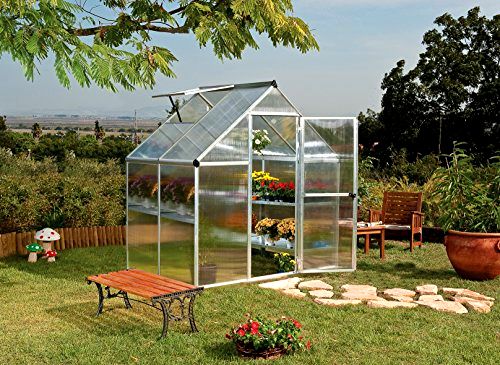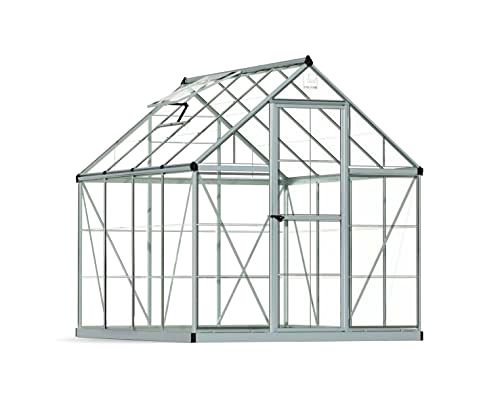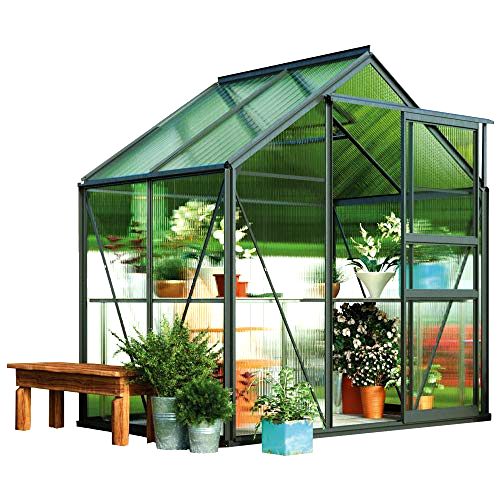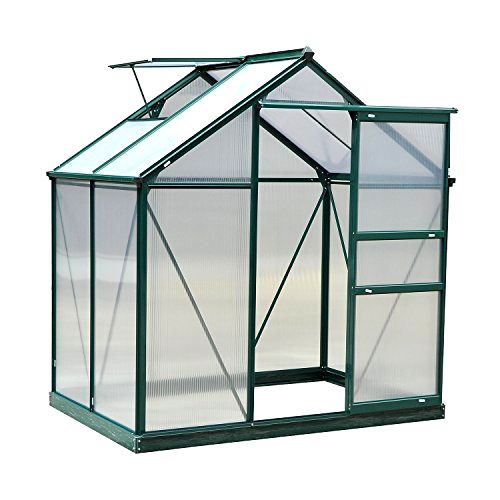Read Reviews
The Best Polycarbonate Greenhouses

-
Palram Mythos Silver Greenhouse (6x4)
-
Palram Harmony Polycarbonate Greenhouse (6x8)
-
Garden Grow Polycarbonate Greenhouse (6x4)
-
Outsunny Clear Polycarbonate Greenhouse (6x4)
-
Selections Wooden Polycarbonate Mini Greenhouse
Polycarbonate Greenhouse Reviews
- Overall construction is very sturdy
- Can withstand relatively high winds (although needs to be bolted/anchored to the ground)
- In some instances can protect from frost in winter without heating
- Comes with a number of spare nuts and bolts included which is useful during assembly
- Door can be fitted to open either way depending on garden layout and personal preference
- Quite lightweight so bolting down is necessary
- Construction can take 1 - 2 days and is a little challenging, even for those with previous DIY knowledge
- Assembly instructions contain diagrams of several models so it can take a little time to interpret them
Due to its high-quality finish and clever design, the Palram Mythos Polycarbonate Greenhouse is a good option to consider.
This 6 x 4 ft (1.83 x 1.22 m) structure has strong ‘canopia’ polycarbonate panels, a hinged door mechanism, and a rust-resistant aluminium frame.
The polycarbonate panels aren’t prone to breaking, and make it possible to assemble the greenhouse without fear of damage. They offer 70% light transmission which can keep a lot of heat inside greenhouses – in some instances, this greenhouse can protect from frost without the use of a heater.
A hinged window is present in the roof, to help regulate the temperature as well as improve ventilation to protect plants from damp and mildew. You may have found that with some greenhouses, ventilation is an add-on that needs to be purchased separately, so it’s nice to see it included here as part of the basic package.
Attached to the roof there is a simple gutter system, and the greenhouse also comes with its own galvanized-steel based included. Although this particular model is silver, there are green and grey options available too.
Overall, it’s one of the best polycarbonate greenhouses due to its construction and the materials used. It can stand up to relatively strong winds as long as it is secured to some sort of foundation.
The construction is a little challenging, and may take 1 – 2 days depending on existing DIY knowledge. Although the instructions are relatively basic, they aren’t difficult to interpret, it just takes some patience to understand the steps.
There are no clips involved to connect the panels together as they slide into the frame, which creates a strong construction once assembled. Also, it’s possible to choose which side the hinged door opens on, so there is some level of customisation available too.
At its highest point, this greenhouse measures 208 cm.
Did you find this review helpful?
- Large size offers plenty of interior space for shelves, plants, tools, etc.
- Does a good job at withstanding strong winds even though it’s very lightweight
- Final construction is sturdy and robust - feels well put together
- All parts are clearly labelled to help with assembly
- Assembly is relatively straight forward (although patience is required and prior DIY knowledge helps)
- Window panel is a little flimsy to open and close
- Construction takes 1 - 2 days and can be a little challenging but mostly just requires patience
If you’re after a large greenhouse, the Palram Harmony Polycarbonate Greenhouse measures 6 x 8 ft (1.83 x 2.44 m) with plenty of space for shelves, flowerpots and growbags.
Unlike the smaller Palram Mythos greenhouse, also featured on this page, this Palram Harmony model has transparent polycarbonate panels that provide over 90% light transmission. Despite being clear like glass, the panels are lighter and much less fragile, making the Palram Harmony easier to assemble than traditional glass greenhouses.
The instructions are basic but straightforward, and assembly takes the best part of a day, if not two days, to complete. Understanding each step can take a bit of patience, and the construction process is made easier by having two people on hand.
When it comes to features, the greenhouse is fitted with some small guttering, a hinged door, and a window for ventilation. The window is perhaps the weakest design element, as it is a little flimsy.
Once constructed, it’s still possible to move the greenhouse around to get it into the right position, and then it needs to be anchored down onto a foundation in order to stop it from being blown away. After being secured, the greenhouse becomes quite resistant to wind.
Included with the greenhouse is a galvanised-steel base which helps hold the structure together. Although this model is silver, it’s also available in green.
Measuring 209 cm at its peak height, and offering plenty of interior space, this is one of the best polycarbonate greenhouses if you have a medium/large garden and are after plenty of growing space. It can be used year-round to protect crops and give plants a head start.
Did you find this review helpful?
- Remains sturdy in strong winds (as long as it's anchored down)
- Sliding door won’t slam in strong winds
- Shatter-proof polycarbonate is easier to handle that traditional glass
- Arrives with all pieces clearly marked and clear instructions
- Detailed assembly video provided by Garden Grow makes the construction process easier
- Takes time to get the base completely level initially
- Although the instructions are good, this greenhouse still requires patience and care to assemble
Although strong winds can sometimes spell disaster for greenhouses, the Garden Grow Polycarbonate Greenhouse is a stable structure that’s capable of standing its ground against gales.
As long as it is properly anchored or secured to a foundation, customers have reported that this greenhouse can withstand storms and other turbulent weather.
It has a sliding door, as opposed to a hinged entryway, so the door won’t slam shut or open with force when the wind picks up.
The frame is made from rust-proof aluminium and the polycarbonate panels are shatter-proof. They’re also corrugated, allowing light to diffuse as it enters the greenhouse.
Complete with rain gutters and a roof window, there are many ways in which this greenhouse is designed to deal with different climates. Ventilation can be used in the summer, to regulate heat, or in the winter to stop lingering damp from causing problems.
Bearing all these factors in mind, it’s one of the best polycarbonate greenhouses for coping with the weather year-round.
Measuring 6 x 4 ft (1.83 x 1.22 m), this is a ‘standard’ size greenhouse suitable for small, medium or large gardens depending on the space available. It has a steel base and can be purchased in either a grey or green colour.
Assembly takes approximately nine hours, and is relatively straight forward – mostly it’s just time consuming because the instructions need to be followed very carefully. There is a useful video online, provided by Garden Grow, to help make the process easier.
Did you find this review helpful?
- Sliding door won’t slam in strong winds
- Door is positioned on longer 6 ft (1.83 m) side which could be desirable for certain garden layouts
- In a sheltered position can withstand strong winds
- Instructions can be difficult to follow
- Assembly is a challenging process overall
- Polycarbonate is a little thin and many customers seal it with additional silicone to stop it coming out
- Very lightweight so will need to be anchored down
- Nuts and bolts supplied aren’t the best quality and may rust over time
This Outsunny Clear Polycarbonate Greenhouse has a different layout to a lot of standard greenhouses (including the other models on this page). This may help it fit into smaller gardens, or gardens that are more unusually shaped.
Measuring 6 x 4 ft (1.83 x 1.22 m), the greenhouse’s door is positioned on its longer 6 ft side, as opposed to the shorter 4 ft side (as is more traditional). Therefore, if you have a wide but short garden, this greenhouse could make better use of the space.
Constructed with an aluminium-alloy frame, tightly corrugated polycarbonate board panels, and a galvanised-steel base, it shares a lot of design characteristics with the other greenhouses featured in this list. There’s also a sliding door and a window for ventilation.
It’s very lightweight, and will need to be anchored down in some way to withstand winds.
It’s also worth noting that the polycarbonate panels are a little thin, and may require a sealant – such as silicone – to ensure they stay in place through all weather. Generally speaking, this greenhouse will need additional reinforcement to ensure it stands the test of time.
Assembly can take upwards of nine hours and requires a lot of patience. There is a 28-page instruction book included which consists of wordless instructions so it’s not for the faint hearted.
Nevertheless, there is a good pay-off at the end, especially if you’re looking for a greenhouse that is wider than it is long. Because of its shape, it’s one of the best polycarbonate greenhouses if you have a shorter garden as it won’t encroach on the space, but it could be just as useful in medium/large gardens too.
Did you find this review helpful?
- A great option for small gardens or patios where there’s not enough space for a walk-in greenhouse
- Keeps temperatures up despite small size
- Shelves are easily accessed either via roof or doors
- Wooden frame makes unit look more attractive
- Only requires a Philips screwdriver to assemble
- Care needs to be taken during assembly to make sure wood doesn't split
- Wood is not the strongest and unit should be treated with some care and kept in a sheltered area
Perfect for smaller gardens, balconies or patios, the Selections Wooden Polycarbonate Mini Greenhouse makes it possible to benefit from a greenhouse in spaces where a larger version isn’t feasible.
It can also be used as an auxiliary greenhouse, offering additional space even if you already have a full-size greenhouse in the garden.
Once assembled, the structure measures 110 cm high and 76 cm wide, with a depth of 57 cm. It’s an attractive unit to have, regardless of where it is placed, with a timber frame that looks classic and traditional.
The stained-wood frame supports twin-walled polycarbonate sheets and there are three shelves inside for housing different plants. It’s easy to access all three shelves, without risking damage to plants, because the hinged lid offers top-access whilst the two hinged doors make it easy to access the middle and bottom shelves.
Despite its small size, this mini greenhouse is still capable of holding in heat, and is ideal for creating a warmer environment for seedlings to grow.
For the price, it offers reasonably good value for money, but there are some shortcomings to be aware of. Primarily, the wood isn’t the strongest – whilst it will do well if treated carefully and kept in a sheltered spot, it may struggle in more exposed areas.
Assembly is straight forward, with only a Philips screwdriver required, but again – care needs to be taken not to tighten the screws too quickly as this can result in the wood splitting.
Overall, if you’re short on space, or are new to gardening, this is one of the best polycarbonate greenhouses to go for due to its size and price. Whilst it’s not the strongest structure ever, it’s still up to the task of caring for a reasonable amount of small plants, and keeping them warm enough to aid growth.
Did you find this review helpful?
How to Choose the Best Polycarbonate Greenhouse
If there’s one thing that’s hard to predict here in the UK, it’s the weather – which probably explains our fascination with talking about it so much!
However, whilst it makes for great small-talk, such changeable weather can make growing plants and produce a little tricky.
Whilst a greenhouse can’t help control the weather, it at least makes it possible for us to regulate the growing conditions for our plants – and isn’t that the next best thing?
Polycarbonate greenhouses are affordable, relatively easy to install and have a range of benefits over glass greenhouses.
If you’re trying to choose the best polycarbonate greenhouse for your garden, the following information will help you make an informed decision:
Benefits of a Polycarbonate Greenhouse
First, we’ll look at the general benefits for having a greenhouse, before moving onto the specific benefits of a polycarbonate greenhouse.
- Warmer growing environment
First and foremost, the air inside a greenhouse will be noticeably warmer than the air outside will be noticeably warmer than the air outside once the sun starts shining. The warmer temperatures mean you’ll be able to grow crops and plants you wouldn’t normally be able to in the UK. See here for the best greenhouse thermometers.
- Longer growing season
On sunny days, your greenhouse will warm up very quickly. This is especially noticeable in the spring and autumn months, where the sun shines but the air still feels a little chilly. Sunny days will extend your growing season.
- Controlled environment
The climate inside a greenhouse is far easier to control. You won’t need to worry about excessive rain, strong winds, frost or pests!
- (Usually!) no planning permission required
In most areas, neither greenhouses nor polytunnels require planning permission as they aren’t permanent structures. However, there are some cases in which you will require planning permission – which are detailed in the FAQs.
Now, here are some of the benefits of having a specifically polycarbonate greenhouse:
- Polycarbonate has a natural UV filter and will protect plants from excessive UV rays
- Thicker polycarbonate is easy to come by and will diffuse light better than glass
- Panels won’t break or smash
There are many more comparisons to be made between polycarbonate and glass greenhouses, which will be explored further in the following section.
Polycarbonate vs Glass Greenhouses
Traditionally, greenhouses exclusively used glass glazing. However, recently, more people have been opting to use polycarbonate instead. So the question is – which is better, and what difference do the materials make?
Glass Glazing
If you favour traditional appearances, you might be keen to opt for glass. Glass greenhouses tend to have a more expensive look (which probably has something to do with the fact that they cost more!) and are a highly aesthetic option.
Practically speaking, glass allows a huge amount of light in to the greenhouse, which is beneficial for plants that thrive in bright conditions.
The pros of glass glazing are:
- It’s a traditional and attractive look
- Glass offers very high light transmission
- It won’t fade or discolour overtime
- The panels are very durable (as long as no impacts cause them to crack or shatter)
- You can recycle old glass using old windows or panes
- It’s easy to replace cracked panes
The cons of glass glazing are:
- It offers no sun protection so your plants may get too hot
- Quite a lot of energy is required to heat and cool a glass greenhouse
- It can be quite an expensive material to buy new
- Installation is challenging because panes are heavy and can break easily
- If panes do break, the broken glass can be dangerous to both humans and animals
- Needs regular cleaning to stop smudges, dirt and debris blocking light unevenly
Polycarbonate Glazing
Quickly rising in popularity, polycarbonate is a type of plastic glazing. Whilst it doesn’t have the beloved, traditional appearance of glass, there are a number of benefits. It’s also possible to buy polycarbonate glazing with varying levels of transparency, depending on what your plants need.
The pros of polycarbonate glazing are:
- It’s flexible and can withstand strong winds without shattering
- Polycarbonate offers better UV protection than glass. Whilst it still lets in warmth and sunlight, UV rays are less likely to damage your plants
- Better insulation than glass – offers a double-glazing effect that’ll keep your greenhouse warmer for longer
- Easier to install than glass thanks to the lighter weight (and the fact there’s no danger of it shattering if dropped)
- Good weather resistance
- Needs far less cleaning than glass
The cons of polycarbonate glazing are:
- It lacks the aesthetic appeal of glass
- Condensation can form between the layers of polycarbonate
- Due to polycarbonate’s lighter weight, panels can blow out if not secured in firmly enough (the greenhouse itself also needs to be firmly secured to the ground)
- Finding a replacement for a broken panel can take longer than it would with glass greenhouses
Choosing the Right Size Greenhouse
Naturally, your outdoor space will dictate what size greenhouse you can physically fit into your garden, but there are other things to bear in mind too.
A 6 x 4 ft (1.83 x 1.22 m) greenhouse is considered ‘standard size’. For most people, this will provide ample room for the plants that you wish to grow or overwinter in there.
If you have a larger garden, and don’t mind taking up a bit more room, then it’s possible to get greenhouses double the standard size, at 6 x 8 ft (1.83 x 2.44 m) – this will give you a lot more space to play with and you’ll be able to grow a lot more plants.
But, be warned: a larger greenhouse will be much harder to heat. In the winter, you may end up spending a pretty penny on heating a large greenhouse, so be sure that you actually need all that space before you go for one.
READ NEXT: How to Heat Your Greenhouse in Winter Without Using Electricity
If you don’t have a lot of space available (or even if you do and you just want a smaller greenhouse unit) there are greenhouses available that are more like cabinets than walk-in buildings. These ‘mini greenhouses’ can be installed anywhere (commonly against the wall of your house) and still have enough space for several seed trays or smaller plants.
Depending on the size and layout of your garden, it may be worth knowing that not every greenhouse has its door positioned on its shorter side. Whilst that might be the more traditional layout, you can also get greenhouses that have their door positioned on the longer side making them wider rather than deeper.
Choosing the Right Style Greenhouse
There are three main greenhouse styles (for walk-in greenhouses). These are: traditional, octagonal and lean-to.
Depending on the size and layout of your garden, you may find that one style makes more sense than the others, so it’s good to have an idea about what’s available on the market.
Traditional greenhouses are the most popular choice. They’re the standard rectangular greenhouse and come in a huge range of sizes and widths to suit almost any garden.
Octagonal greenhouses have an additional aesthetic element, as well as being practical. Octagonal greenhouses can look extremely modern and create a focal point in the garden. They tend to be placed in more of a central location rather than being hidden into corners.
Lean-to greenhouses are perfect for smaller gardens, although they can work in any space. These take advantage of an existing wall in the garden, with one flat side that gets positioned against the wall. If positioned against the wall of the house, these greenhouses can benefit from some of the heat from the wall.
READ NEXT: The Best Popup Greenhouse
Greenhouse Doors and Openable Windows
Some greenhouses have a hinged door that opens outwards whilst others have a sliding door. You may even come across greenhouses that have a door at each end for easier access.
Sliding doors are one of the best options for small gardens. They slide open and closed without needing to encroach on any garden space. They’re also great in windy weather as they won’t slam or fly open, as a hinged door might.
Hinged doors can be easier to open that sliding doors, but they have the disadvantage of slamming and flapping if they are not closed properly.
When it comes to windows, these can be important for helping with ventilation in the greenhouse. If the greenhouse doesn’t have openable windows, it will need some other form of ventilation. On hotter days, greenhouses can easily overheat, which can damage and even kill a lot of your plants.
Even in cooler weather, good ventilation is required to stop damp and mildew from hanging around which could cause mould.
Polycarbonate Greenhouse FAQs
There is no set thickness that’s used for polycarbonate greenhouses. However, those made with thicker polycarbonate tend to have better insulation (but they can block more sun).
For the UK climate, a thickness of around 4 mm or more will be perfect. This tends to give a good balance of insulation and light.
4 mm panels may not succeed in completely keeping the frost out during winter. You will likely need a greenhouse heater, or thicker panels, to achieve this. See here on how to prepare your greenhouse for winter.
It’s important that the roof of your greenhouse is able to catch direct sunlight, but it should still be installed in a slightly sheltered area. Hedges or fences will provide a small amount of shelter from very strong winds.
Avoid installing your greenhouse near overhanging trees. Not only can these damage your greenhouse, they can also make it dirty (which can, in turn, block light).
If you’re planning on having a water supply and electricity in your greenhouse, the location is very important. If you’d like to install a heater, lighting, grow lights, propagators or automatic watering systems, you’ll almost definitely need a water or electricity source.
Finally, you need to consider the greenhouse’s foundation. Ideally, you’ll need a level or almost level site. Some gardeners opt to lay flag stones or slabs, which should be securely bedded.
While many greenhouses come with a base included, you’ll still need a foundation to properly secure your greenhouse.
In most cases, you won’t require planning permission to install a greenhouse in your garden.
However, there are some instances where planning permission may be required. You may require planning permission if:
- Your greenhouse will be installed in an area that it’s highly visible to passers by and neighbours – for example in your front garden
- You live in a National Park
- Your house is a listed building
- The greenhouse is going to be installed within 2m of the edge of the boundary of your property
- The greenhouse is over 2.5m tall
- 50% or more of your garden is occupied by outbuildings
If you are in any doubt over planning permission, it’s highly recommended that you contact your local council.






Share